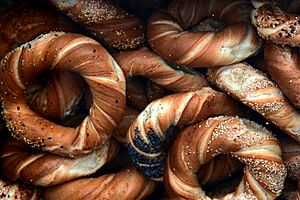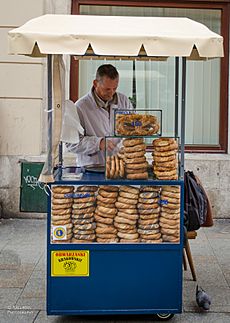Obwarzanek krakowski facts for kids

An obwarzanek krakowski sprinkled with poppy seeds
|
|
| Type | Street food |
|---|---|
| Region or state | Kraków, Poland |
| Associated national cuisine | Polish |
| Serving temperature | Room temperature |
| Main ingredients | Wheat flour, fat (usually lard), yeast, sugar, salt |
| Ingredients generally used | Coarse salt, poppy seeds, sesame seeds (for sprinkling) |
| Variations | Depend on the sprinkling |
| Similar dishes | Bagel, bublik, pretzel |
An obwarzanek krakowski is a special kind of bread from Kraków, Poland. It looks like a braided ring. Before it's baked, it gets boiled and sprinkled with things like salt, sesame seeds, or poppy seeds.
This tasty snack has a crunchy, golden-brown outside. Inside, it's soft, a bit sweet, and chewy. You'll often find obwarzanki sold from street carts in Kraków. It's so important there that it's a protected regional food. It's a bit like a bagel or a pretzel, but it's unique!
Contents
What Does Obwarzanek Mean?
The name obwarzanek krakowski comes from the Polish language. The word obwarzanek means "something that has been parboiled."
"Parboiling" means boiling something briefly before cooking it fully. This is a special step in making obwarzanki. The word krakowski simply means "from Kraków." So, it's a "parboiled ring from Kraków"!
What Does an Obwarzanek Look Like?
An obwarzanek krakowski is shaped like a ring or an oval. It has a hole in the middle. Its surface is made of twisted strands of dough, like a spiral.
The color can be light golden or light brown, and it often looks a bit shiny. A typical obwarzanek is about 12 to 17 centimeters (5 to 7 inches) wide. It is about 2 to 4 centimeters (1 to 2 inches) thick. Each one usually weighs between 80 and 120 grams (about 3 to 4 ounces).
The twisted parts on the outside feel firm. The inside is soft, pale, and a little moist. It tastes slightly sweet, which is common for baked goods that are boiled first. Obwarzanki are often topped with different things. These include coarse salt, poppy seeds, sesame seeds, or even grated cheese.
How Is an Obwarzanek Made?
The dough for obwarzanki is mostly made from wheat flour. Sometimes, a bit of rye flour is added too. Other important ingredients are fat, sugar, yeast, salt, and water.
First, all the ingredients are mixed together. The dough then rests for a while to rise. This can take from a few minutes to an hour. After rising, the dough is divided into smaller pieces. These pieces are rolled out and cut into strips.
Bakers then twist two or three strips of dough together to make a spiral. They form this spiral into a ring by wrapping it around their hand. The ring is then pressed onto a table. Next, the rings are left to rise again.
The special step is next: the rings are briefly boiled in hot water. The water must be at least 90 degrees Celsius (194°F). They are boiled until they float to the surface. Sometimes, a tiny bit of honey is added to the water. After boiling, the obwarzanek is decorated with toppings and then baked until golden.
Once they cool down, obwarzanki can be packaged. But they are usually sold fresh and unpackaged. If they are packed too soon, they can lose their crunchiness.
The History of Obwarzanek
The first mentions of obwarzanki in Kraków go way back to the year 1394. Records from the royal court of King Władysław II Jagiełło and Queen Jadwiga of Poland talk about them. An old record mentions buying "rings of obwarzanki" for the queen.
In 1496, King John I Albert gave the bakers' guild in Kraków a special right. Only bakers in this guild could make white bread, including obwarzanki. This special right was confirmed by many Polish kings after him.
At first, obwarzanki could only be made during Lent. Only certain bakers chosen by the guild were allowed to make them. In 1611, the guild even made rules about where obwarzanki could be sold inside the city walls.
Things changed in the 1800s. In 1802, a new rule said that any baker could make obwarzanki when it was their turn. Bakers would draw lots to decide whose turn it was. This system of drawing lots likely ended around 1849. Today, any baker can make obwarzanki any day of the year.
<mapframe text="Obwarzanek krakowski (protected geographical indication) may be produced only in the city of Kraków and the adjacent Kraków and Wieliczka counties." width=200 height=200 zoom=8 latitude=50.1 longitude=19.9 align=left>[ {"type": "ExternalData", "service": "geoshape", "ids": "Q31487", "properties": { "fill": "#DAA520" } }, //Kraków city {"type": "ExternalData", "service": "geoshape", "ids": "Q1164890", "properties": { "fill": "#DAA520" } }, //Kraków county {"type": "ExternalData", "service": "geoshape", "ids": "Q609424" , "properties": { "fill": "#DAA520" } } //Wieliczka county ]</mapframe> In the past, obwarzanki were sold from stalls that opened very early. This way, people could buy them fresh in the morning. The bakers' guild checked the quality of the products. Any baker who broke the rules was punished. Later, people started selling them in other ways, like from wicker baskets.
Obwarzanki Today
Today, you can buy obwarzanki in shops and bakeries. But they are still very popular from street carts. Kraków has about 170 to 180 such carts. On average, almost 150,000 obwarzanki are sold in Kraków every single day!
The obwarzanek krakowski is a famous symbol of Kraków. It's often used in ads to promote the city to both locals and tourists. It has even won awards for its culinary heritage. It's also a main feature at Kraków's regular bread festival, called Święto Chleba.



